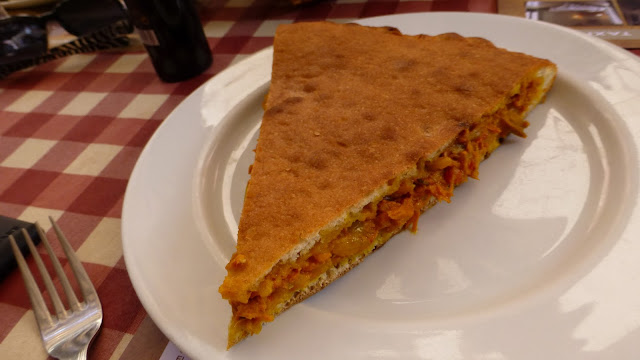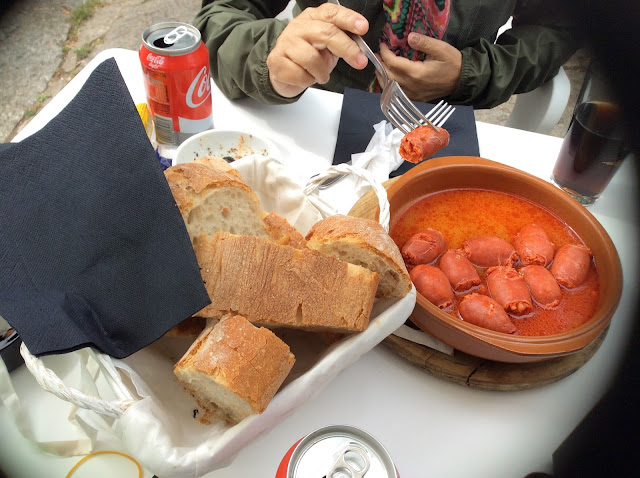"Lose weight, gain faith". This was the slogan that we, the Amigos de Santiago had when we embarked on our Camino de Santiago. I am sure we all gained faith as the Camino was a life enhancing experience, teaching us many lessons along the way.
Some amigos did lose weight -- after all, we walked 134 kilometres in the course of 11 days.
However, I came home, weighed myself and learned that I had lost only 4 measly pounds.
But perhaps I should be grateful that I didn't gain weight because I certainly indulged in my own culinary camino around Spain.

We started our Camino in Triacastela, in the province of Galicia. The very first Galician
specialty that I had was a large wedge of empanada. This baked savoury two-crust pie comes
in different varieties -- chicken, chorizo, ham or tuna. Empanada is omnipresent in various
cafes and bars along the Camino as it is an easy-to-eat, affordable snack or meal.

Galicia must have millions of cows, at least that's what it seemed like to me, seeing them
every where while walking along the Camino. White and brown cows are raised for meat and
black and white cows are dairy cows. Galicia provides one third of all milk produced in Spain.
And most of that milk is made into heavenly Galician cheeses.
Some Galician cheeses have their own PDO or Protected Designation of Origin. One of these
is Cebreiro which has a mild, creamy taste. Soft and spreadable, it is great with crackers or the crusty, thick Spanish bread.
Galicia is also known for its potatoes and these are used in copious quantities in caldo Gallego -
a soup that is comfort food at its best. This dish introduced me to the uniquely Galician vegetable called grelos, kale-like greens that grow in practically every backyard. Aside from potatoes and grelos, caldo Gallego has leeks, onions and white beans and is cooked with beef or ham stock. Sometimes I'd find chunks of meat or chorizo in my caldo Gallego.
A bowl of this hot soup was wonderfully restorative after a long walk.

Pork is another Galician specialty -- pigs are grown in small and medium sized family farms.
I did not see a single pig farm along the Camino although I saw a lot of cows in barns and
grazing in the fields. Perhaps the pig farms are hidden from view (and smell).
I had the best pork chops ever in Bar Fernandez in Triacastela where the chops were juicy and
fried to perfection. They were seasoned with just salt and pepper and came with a generous pile
of patatas fritas.
To go with the pork chops -- a bottle of the local Ribeiro. Ribeiro is an area in Galicia that produces both red and white wines. I am not a big wine drinker but the Ribeiro reds and whites grow on
you and make very pleasant dinner companions.
Torta de Santiago is not an omelette -- it's an almond cake that's the most famous cake in Galicia. Slightly dense and not always moist, it is finished off with a sprinkling of powdered sugar and emblazoned with the cross of St. James. This cake is usually present at the breakfast table and always offered up as a dessert. Not surprisingly, it goes well with a glass of Ribeiro red.
But not at breakfast -- only after dinner.
While chorizos can be found all throughout Spain, Galicians are particularly proud of their own. There are even chorizo festivals in the small towns. These chorizos a vinagre or chorizos cooked in vinegar were tart and tasty with a sauce that was very conducive to bread dunking and sopping. We found this amazing dish in an albergue in Mercadoiro, along the back roads of the Camino.
and sprinkled with paprika, sea salt and olive oil, the octopus is easy to eat and goes well with an
ice cold bottle of cerveza. The town of Melide is famous for its pulpo but this plate that I had in Meson o Rodriguez in Portomarin was excellent as well.
Pimientos de padron are delicious Galician oddities -- they are little green peppers that look
fierce and hot but have absolutely no heat at all. Well, once in a while, a "rogue" pepper can
surprise you but I haven't had that kind of luck so far. They make a wonderful tapas --
just fried and sprinkled with rock salt.
I ordered this plate of fresh sardines and pimientos de padron in a small bar off the church
square in Melide.
We stayed in an exceptional Casa Rural or B&B ten minutes away from Arzua called
Casa Brandariz. The hospitable and charming owner and chef, Mari Carmen prepared filloas -- Galician crepes which can be savoury or sweet. These vegetarian filloas were served as
appetisers and were a wonderful way to start the meal.
In may not be uniquely Galician but Mari Carmen told us that the cheese used in these stuffed pequillo peppers was produced right in their farm next door.
Merluza or hake is a firm white fish that is often used in the Galician kitchen. At Casa Brandariz, we enjoyed the Merluza a la Gallega or fish steaks Galician style. The merluza was sliced thickly and baked along with peas, potatoes, garlic and olive oil -- all in all, a very substantial meal.

Galicia is a coastal province and the seafood is always fresh. We had appetisers of Galician
style scallops in Hotel Ruta Jacobea in Lavacolla. Baked in a white wine sauce, with bits of
ham and a golden, crusty breadcrumb topping, it was a flavourful homage to the scallop,
the symbol of Santiago and the Camino.
Before I left for the Camino, I did a bit of research on the must-eat specialties of Galicia
and percebes was always highly recommended.
Percebes are goose neck barnacles that grow on rocks along the Galician coast.
Perhaps because of the difficulty in harvesting them and their short season, percebes are
devilishly expensive and one of the few items sold by weight in restaurants.
I finally had percebes in Santiago de Compostela, in Restaurante San Jaime.
This small plate of percebes weighing 200 grams cost us 24 euros.
How to free the percebes from its soft shell? Hold one end and twist the flesh out. It doesn't
look like much - it looks downright ugly but percebes are very tasty morsels that taste strongly
of the sea. It is not an acquired taste -- once you try one, you will definitely reach for another.
At Restaurante San Jaime, I ordered a slice of tetilla cheese with membrillo or quince jelly
for dessert. Tetilla cheese is inherently Galician and has a PDO. Pale yellow in colour, I
tasted a hint of butter but the cheese itself is quite mild. The sweetness of the membrillo
coaxes out the taste of the cheese. Tetilla means "nipple" in Spanish -- and a whole piece
of this cheese is shaped like a woman's breast.
Cozy Restaurante San Jaime was a fitting place to mark our last night in Santiago de Compostela. Our little table overlooked the charming Plaza de Fonseca where it was still bright and sunny at
9:00 p.m. With percebes, tetilla and cerveza Estrella Galicia on the table, I knew these singular
tastes of Galicia would linger in my taste buds for a long long time.














No comments:
Post a Comment